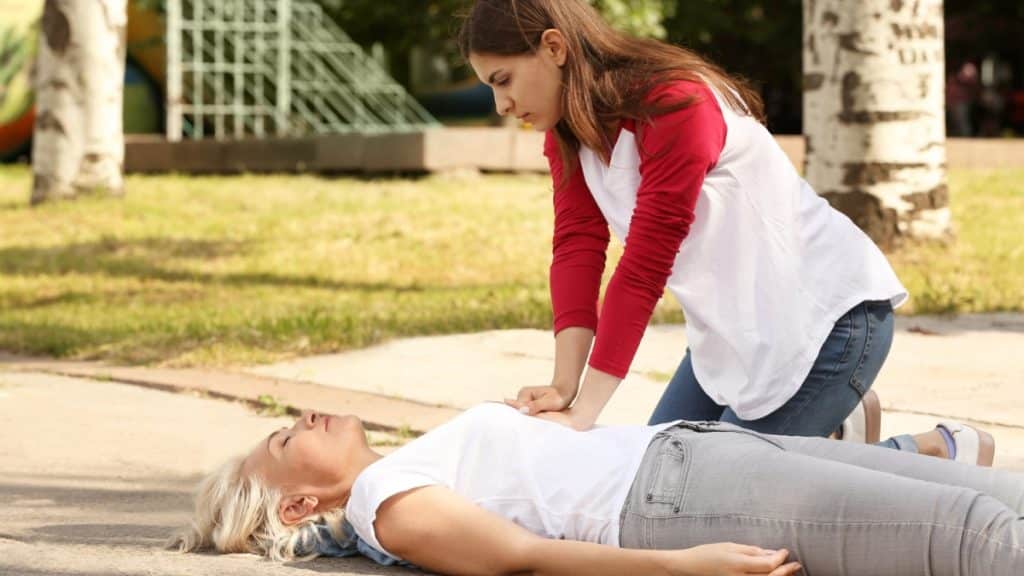CPR, or cardiopulmonary resuscitation can help a person survive a cardiac arrest until the emergency services arrive. Even if you do not know complete CPR, you can help someone by using “hands-only CPR”.
CPR (cardiopulmonary resuscitation) is a way to save someone’s life. Resuscitating or reviving someone means keeping blood or oxygen flowing through the body of the person having a cardiac arrest. Anyone can learn this technique, as it is fairly simple and does not require any certification. The key part of CPR is chest compressions. These compressions keep the blood flowing to vital organs until a regular heartbeat returns.
CPR Steps- A Quick Guide
To remember the CPR steps you need to memorise the term CAB:
- C for chest compressions
- A for opening a person’s airway
- B for giving them rescue breaths
CPR is performed when a person is not breathing or gasping for breath while not responding to questions. In case you find yourself in a situation where you need to perform CPR, check that the area is safe and perform the following basic steps:
- Call emergency services
- Lay the person on their back and check for breathing
- In case they are not breathing, start CPR
- Keep both your hands centred on their chest
- Your shoulders should be aligned directly over your hands with your elbows locked
- Now perform 30 chest compressions
- Each compression should be at least 2 inches deep
- You must give 100 to 120 chest compressions per minute
- Allow the chest to return to normal position before giving another compression
- After every 30 chest compressions give 2 rescue breaths
- Pinch their nose shut and make a complete seal over the person’s mouth with your mouth
- One breath should last 1 second and should make the chest rise
- Keep repeating this process until the ambulance arrives
When to Give CPR- Warning Signs
The following signs can determine if a person requires CPR:
- The Person is Not Breathing: If the person is not breathing on his own, it is a major sign that CPR is required to circulate oxygenated blood throughout their body. Remember that an average person can only go without oxygen between four and six minutes before irreversible brain damage occurs. Therefore, if you start CPR within that time, the person has a chance of surviving without much brain damage.
- The Heart is Not Beating: Check for a pulse on the back of the wrist or side of the neck and if you are unable to find one, start performing CPR. Chest compressions will keep the blood flowing to the heart and brain until emergency responders arrive and try other revival methods.
- The Person Becomes Unresponsive/Unconscious: If you find the person unable to respond or unconscious and he/she is not breathing, CPR is recommended.
If you face any of the above situations and determine that a person needs CPR, take action immediately. The faster you respond, the higher the chances of survival.
Once the medical help arrives, the person should be referred to the cardiology department, where specialist doctors, such as the best cardiologists in Hyderabad at Apollo Hospital Hyderabad, can determine the underlying cause of this emergency event.
When Can You Perform A CPR?
Emergency situations where a CPR can be performed include:
- Sudden cardiac arrest
- Car accidents
- Near drowning
- Electrocution
- Sudden Collapse
Conclusion
CPR is a first-aid procedure that can save someone’s life. If performed in a timely and correct way, it can improve the chances of surviving a cardiac arrest or an accident or trauma. However, keeping tabs on your heart health can also help you avoid life-threatening emergencies. Seeking professional help from the best cardiologists in Hyderabad at Apollo Hospital Hyderabad, can make all the difference in ensuring a healthy heart and overall well-being.
Angela Spearman is a journalist at EzineMark who enjoys writing about the latest trending technology and business news.

